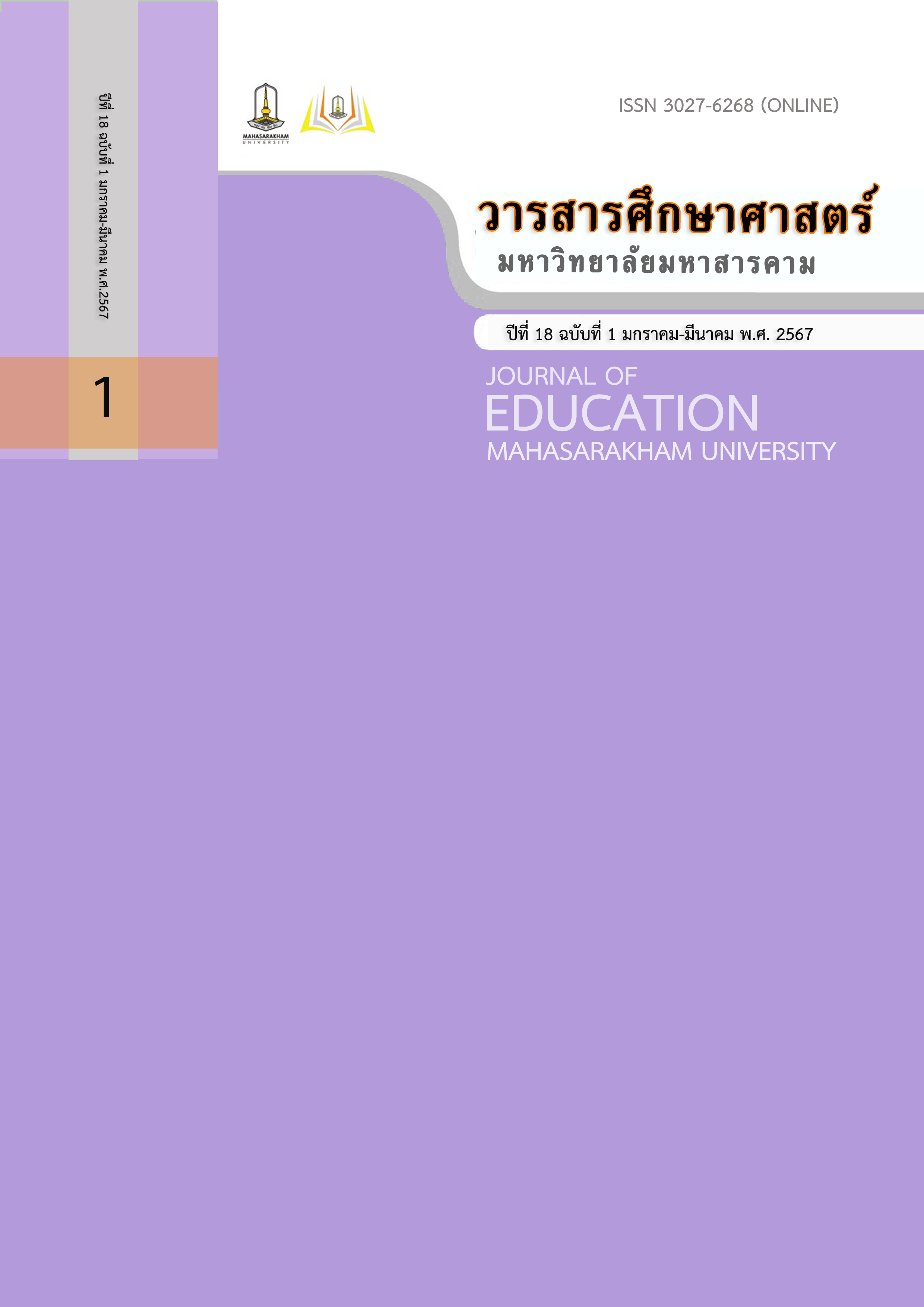Developing Computer-assisted Instruction following the Gagne Approach for Grade 6 Students: A Case Study in Dramatic Arts Subject
Main Article Content
Abstract
The purposes of this study were to develop and find efficiency with computer-assisted instruction in dramatic arts subject for grade 6 students, to compare academic achievement before and after studying dramatic arts using computer-assisted instruction, and to study student satisfaction with computer-assisted instruction in the dramatic arts subject. The sample group used in this research included 12 students in Grade 6 at Thai Christian Sapan Luang School, academic year 2023, by using purposive sampling. The research instruments used were: 1) computer assisted instruction in dramatic arts course using the Gagne concept, 2) achievement test for dramatic arts subjects, and 3) student satisfaction questionnaire with computer assisted instruction teaching of dramatic arts. Statistics used in data analysis included mean, standard deviation (SD), test the effectiveness of the lesson using the E1/E2 formula, and the Wilcoxon Matched Pairs Signed Ranks Test.
The research results found that: 1) the efficiency value of dramatic arts learning with computer assisted instruction using the Gagne concept for grade 6 students equalled to 81/80, in line with the 80/80 criteria set forth, 2) for the academic achievement in dramatic arts subject using computer assisted instruction for grade 6 students, the post-test was significantly higher than pre-test at the .01 level, consistent with the research hypotheses, and 3) for the results of the study of students’ satisfaction with computer assisted instruction of dramatic arts subject, using the concept of Gagne for grade 6 students, satisfaction was found to be at the highest level ( =4.51, S.D.=0.50)
Downloads
Article Details

This work is licensed under a Creative Commons Attribution-NonCommercial-NoDerivatives 4.0 International License.
References
กระทรวงศึกษาธิการ. (2551). หลักสูตรแกนกลางการศึกษาขั้นพื้นฐาน พุทธศักราช 2551. กรุงเทพฯ: องค์การรับส่งสินค้าและพัสดุภัณฑ์.
แก้วตา ชมพูอาจ. (2558). การพัฒนาบทเรียนคอมพิวเตอร์ช่วยสอนเรื่อง นาฏลีลาและนาฏยศัพท์ สำหรับนักเรียนชั้นประถมศึกษาปีที่ 6 โรงเรียนเลิศพัฒนาศึกษา. (วิทยานิพนธ์มหาบัณฑิต). สาขาวิชาหลักสูตรและการสอน. มหาวิทยาลัยราชภัฎธนบุรี.
จรรยา โพธิกุดไสย. (2565). การพัฒนาบทเรียนคอมพิวเตอร์ช่วยสอนโดยใช้แนวคิดของกาเย่ เรื่อง การอ่านจับใจความจากข้อมูลทางวัฒนธรรมสำหรับนักเรียนชั้นมัธยมศึกษาปีที่ 1. (วิทยานิพนธ์มหาบัณฑิต). ภาควิชาหลักสูตรและวิธีสอน. มหาวิทยาลัยศิลปากร.
ฐิติพร บุญธรรม. (2562). การพัฒนาการจัดกิจกรรมการเรียนรู้โดยใช้บทเรียนคอมพิวเตอร์ช่วยสอนร่วมกับการใช้แผนผังมโนทัศน์ เรื่อง การรักษาดุลยภาพในร่างกาย ของนักเรียนชั้นมัธยมศึกษาปีที่ 4. (วิทยานิพนธ์มหาบัณฑิต). สาขาวิชาชีววิทยาศึกษา. มหาวิทยาลัยมหาสารคาม.
ณิรดา เวชญาลักษณ์. (2564). การบริหารจัดการเรียนรู้. พิมพ์ครั้งที่ 1. กรุงเทพฯ: วนิดาการพิมพ์.
นิติญาภรณ์ ศรีไพร. (2563). การพัฒนาทักษะการปฏิบัติ โดยใช้วิธีการสอนแบบห้องเรียนกลับด้าน ร่วมกับสื่อคอมพิวเตอร์ช่วยสอน (CAI) รายวิชานาฏศิลป์ ชั้นมัธยมศึกษาปีที่ 2 โรงเรียนภูเวียงวิทยาคม. สํานักงานเขตพื้นที่การศึกษามัธยมศึกษาเขต 25 จังหวัดขอนแก่น.
นิภา ศรีไพโรจน์. (2533). สถิตินอนพาราเมตริก. พิมพ์ครั้งที่ 2. กรุงเทพฯ: โอเดียนสโตร์.
บุญเลี้ยง ทุมทอง. (2559). ทฤษฎีและการพัฒนารูปแบบการจัดการเรียนรู้. พิมพ์ครั้งที่ 3. กรุงเทพฯ: บริษัททริปเพิ้ลกรุ๊ปจำกัด.
ประวิทย์ ฤทธิบูลย์, (2558). นาฏศิลป์ไทย สื่อทางวัฒนธรรมที่มากกว่าความบันเทิง. วารสารศาสตร์วิชาการวิจัย และงานสร้างสรรค์ คณะศิลปกรรมศาสตร์ มหาวิทยาลัย เทคโนโลยีราชมงคลธัญบุรี. 106-137.
ปรีดา ขำจิตต์. (2562). ปัจจัยที่ส่งผลต่อเจตคติต่อการเรียนวิชานาฏศิลป์ ของนักเรียนชั้นมัธยมศึกษาตอนต้นสำนักงานเขตพื้นที่การศึกษาประถมศึกษากาญจนบุรี เขต 1. สิกขา วารสารศึกษาศาสตร์คณะศึกษาศาสตร์ มหาวิทยาลัยวงษ์ชวลิตกุล. 6(2), 56-67.
เลอสันต์ ฤทธิขันธ์. (2564). การพัฒนาบทเรียนคอมพิวเตอร์ช่วยสอนแบบมีปฏิสัมพันธ์ เรื่อง เทคโนโลยีสารสนเทศ และการสื่อสารสำหรับนักเรียนชั้นประถมศึกษาปี 2 ที่โรงเรียนสาธิต มหาวิทยาลัยราชภัฎบุรีรัมย์. วารสารเทคโนโลยีและการสื่อสารการศึกษา. คณะ ศึกษาศาสตร์. มหาวิทยาลัยมหาสารคาม. 4(10), 137-146.
ล้วน สายยศ และ อังคณา สายยศ. (2538). เทคนิคการวิจัยทางการศึกษา. พิมพ์ครั้งที่ 5. (ปรับปรุง) กรุงเทพมหานคร : สุวีริยาสาส์น.
สุไม บิลไบ. (2557). การออกแบบและพัฒนาบทเรียนมัลติมีเดียโดยใช้ ADDIE Model. เอกสารประกอบการสอน นวัตกรรมและเทคโนโลยีสารสนเทศทางการศึกษา. สืบค้นเมื่อ 13 พฤศจิกายน 2566 จากhttps://drsumaibinbai.files.wordpress.com/2014/12/addie_design_sumai.pdf.
เสาวนีย์ สิกขาบัณฑิต. (2548). เทคโนโลยีการศึกษา. กรุงเทพฯ: สถาบันเทคโนโลยีพระจอมเกล้าพระนครเหนือ.
Nazimuddin, S.K. (2014). Computer Assisted Instruction (CAI): A New Approach in the Field of Education. International Journal of Scientific Engineering and Research (IJSER), 3(July), 185-188.


